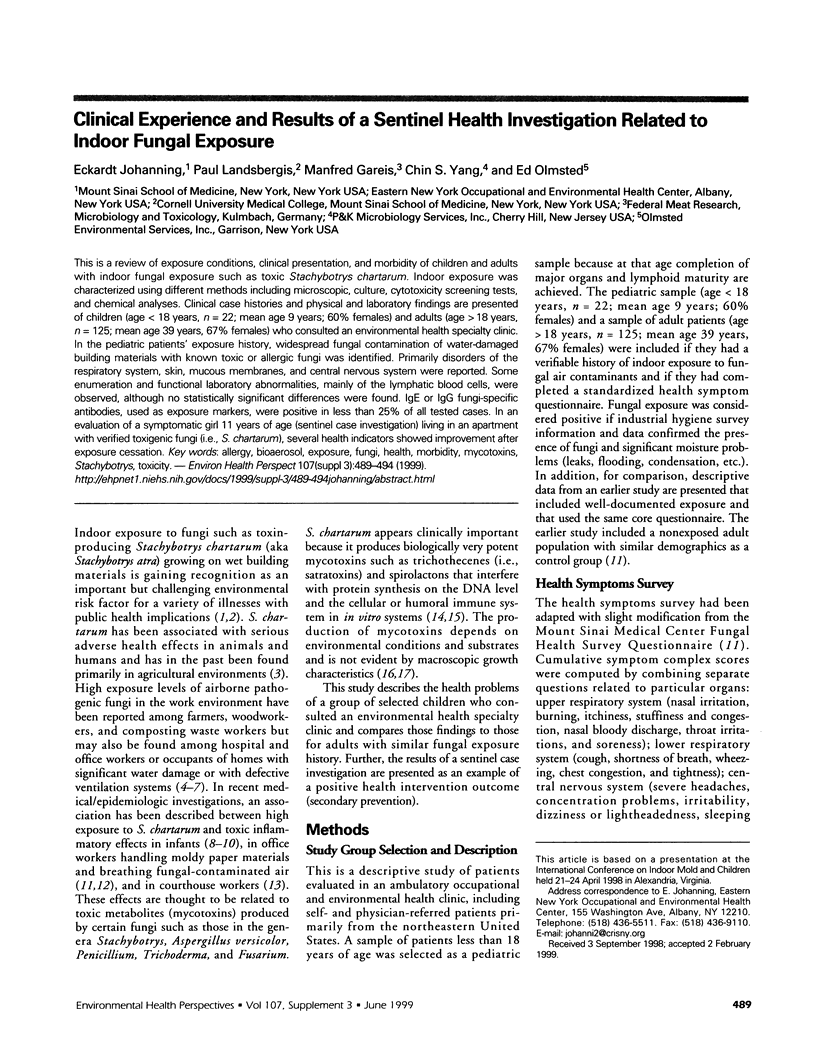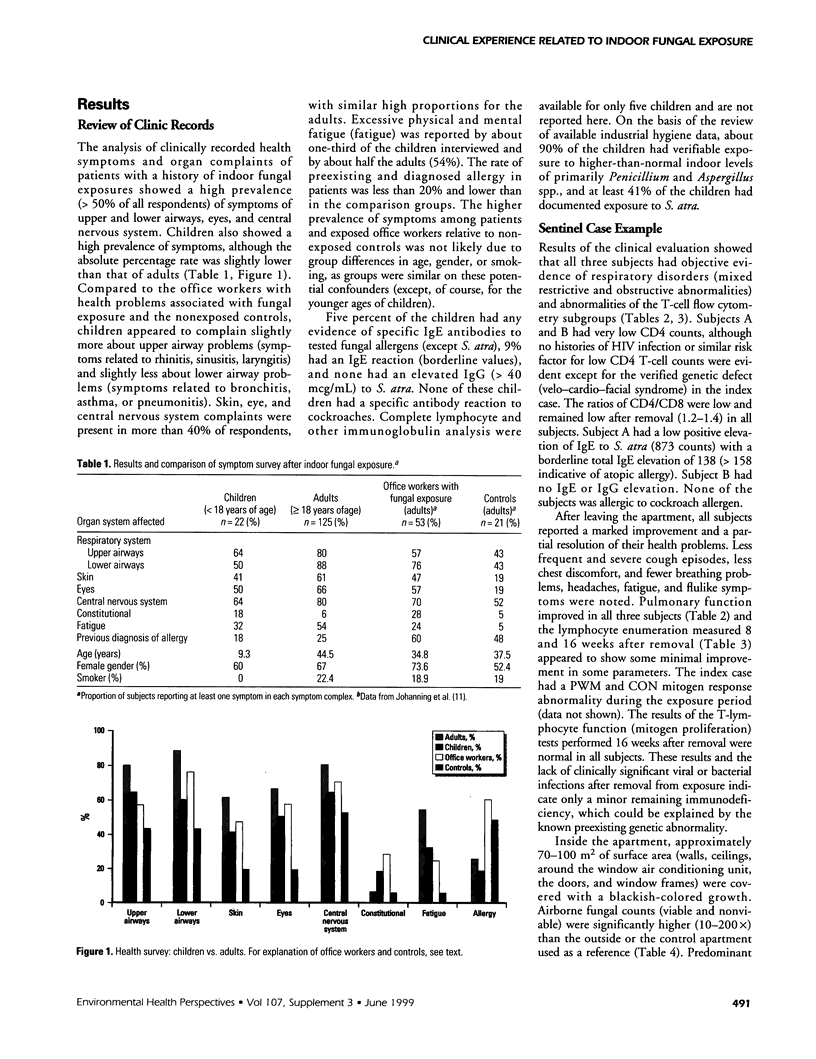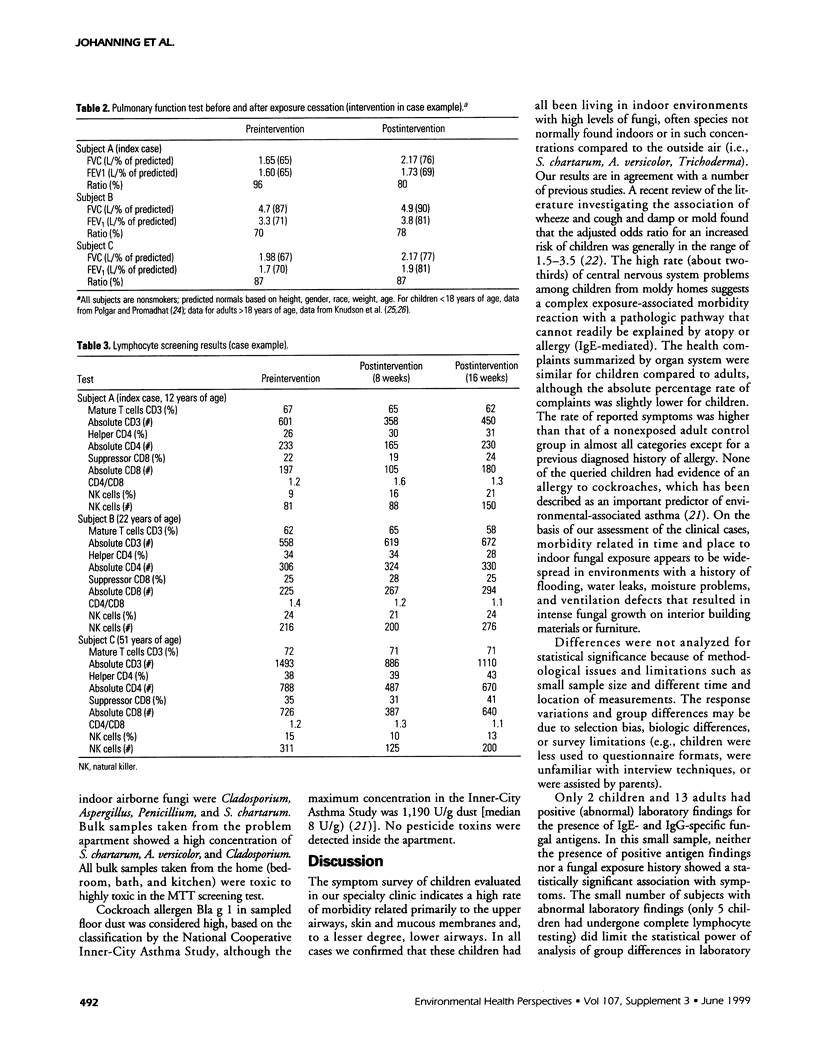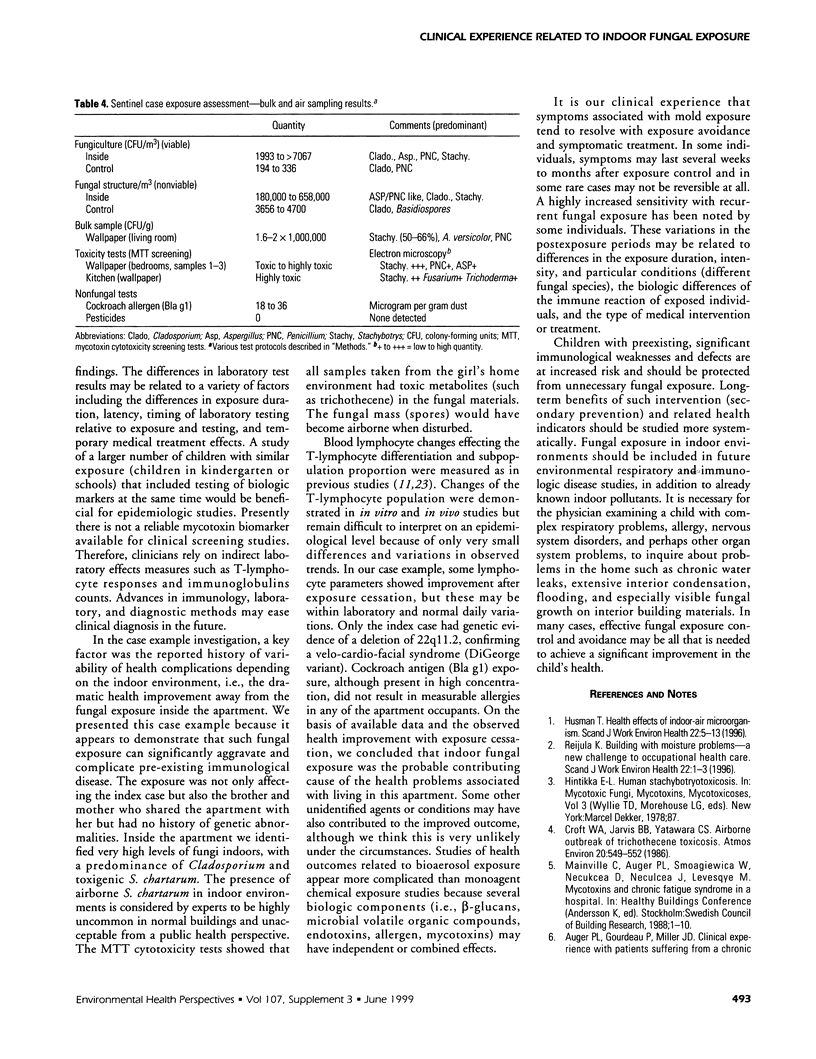Abstract
This is a review of exposure conditions, clinical presentation, and morbidity of children and adults with indoor fungal exposure such as toxic Stachybotrys chartarum. Indoor exposure was characterized using different methods including microscopic, culture, cytotoxicity screening tests, and chemical analyses. Clinical case histories and physical and laboratory findings are presented of children (age < 18 years, n = 22; mean age 9 years; 60% females) and adults (age >18 years, n = 125; mean age 39 years, 67% females) who consulted an environmental health specialty clinic. In the pediatric patients' exposure history, widespread fungal contamination of water-damaged building materials with known toxic or allergic fungi was identified. Primarily disorders of the respiratory system, skin, mucous membranes, and central nervous system were reported. Some enumeration and functional laboratory abnormalities, mainly of the lymphatic blood cells, were observed, although no statistically significant differences were found. IgE or IgG fungi-specific antibodies, used as exposure markers, were positive in less than 25% of all tested cases. In an evaluation of a symptomatic girl 11 years of age (sentinel case investigation) living in an apartment with verified toxigenic fungi (i.e., S. chartarum), several health indicators showed improvement after exposure cessation.
Full text
PDF





Images in this article
Selected References
These references are in PubMed. This may not be the complete list of references from this article.
- Auger P. L., Gourdeau P., Miller J. D. Clinical experience with patients suffering from a chronic fatigue-like syndrome and repeated upper respiratory infections in relation to airborne molds. Am J Ind Med. 1994 Jan;25(1):41–42. doi: 10.1002/ajim.4700250110. [DOI] [PubMed] [Google Scholar]
- Corrier D. E. Mycotoxicosis: mechanisms of immunosuppression. Vet Immunol Immunopathol. 1991 Nov;30(1):73–87. doi: 10.1016/0165-2427(91)90010-a. [DOI] [PubMed] [Google Scholar]
- Dales R., Miller D., White J., Dulberg C., Lazarovits A. I. Influence of residential fungal contamination on peripheral blood lymphocyte populations in children. Arch Environ Health. 1998 May-Jun;53(3):190–195. doi: 10.1080/00039899809605694. [DOI] [PubMed] [Google Scholar]
- Etzel R. A., Montaña E., Sorenson W. G., Kullman G. J., Allan T. M., Dearborn D. G., Olson D. R., Jarvis B. B., Miller J. D. Acute pulmonary hemorrhage in infants associated with exposure to Stachybotrys atra and other fungi. Arch Pediatr Adolesc Med. 1998 Aug;152(8):757–762. doi: 10.1001/archpedi.152.8.757. [DOI] [PubMed] [Google Scholar]
- Hanelt M., Gareis M., Kollarczik B. Cytotoxicity of mycotoxins evaluated by the MTT-cell culture assay. Mycopathologia. 1994 Dec;128(3):167–174. doi: 10.1007/BF01138479. [DOI] [PubMed] [Google Scholar]
- Hodgson M. J., Morey P., Leung W. Y., Morrow L., Miller D., Jarvis B. B., Robbins H., Halsey J. F., Storey E. Building-associated pulmonary disease from exposure to Stachybotrys chartarum and Aspergillus versicolor. J Occup Environ Med. 1998 Mar;40(3):241–249. doi: 10.1097/00043764-199803000-00006. [DOI] [PubMed] [Google Scholar]
- Husman T. Health effects of indoor-air microorganisms. Scand J Work Environ Health. 1996 Feb;22(1):5–13. doi: 10.5271/sjweh.103. [DOI] [PubMed] [Google Scholar]
- Johanning E., Auger P. L., Reijula K. Building-related illnesses. N Engl J Med. 1998 Apr 9;338(15):1070–1071. doi: 10.1056/NEJM199804093381514. [DOI] [PubMed] [Google Scholar]
- Johanning E., Biagini R., Hull D., Morey P., Jarvis B., Landsbergis P. Health and immunology study following exposure to toxigenic fungi (Stachybotrys chartarum) in a water-damaged office environment. Int Arch Occup Environ Health. 1996;68(4):207–218. doi: 10.1007/BF00381430. [DOI] [PubMed] [Google Scholar]
- Johanning E. Stachybotrys revisited. J Toxicol Clin Toxicol. 1998;36(6):629–631. doi: 10.3109/15563659809028061. [DOI] [PubMed] [Google Scholar]
- Knudson R. J., Lebowitz M. D., Holberg C. J., Burrows B. Changes in the normal maximal expiratory flow-volume curve with growth and aging. Am Rev Respir Dis. 1983 Jun;127(6):725–734. doi: 10.1164/arrd.1983.127.6.725. [DOI] [PubMed] [Google Scholar]
- Knudson R. J., Slatin R. C., Lebowitz M. D., Burrows B. The maximal expiratory flow-volume curve. Normal standards, variability, and effects of age. Am Rev Respir Dis. 1976 May;113(5):587–600. doi: 10.1164/arrd.1976.113.5.587. [DOI] [PubMed] [Google Scholar]
- Nikulin M., Pasanen A. L., Berg S., Hintikka E. L. Stachybotrys atra Growth and Toxin Production in Some Building Materials and Fodder under Different Relative Humidities. Appl Environ Microbiol. 1994 Sep;60(9):3421–3424. doi: 10.1128/aem.60.9.3421-3424.1994. [DOI] [PMC free article] [PubMed] [Google Scholar]
- Peat J. K., Dickerson J., Li J. Effects of damp and mould in the home on respiratory health: a review of the literature. Allergy. 1998 Feb;53(2):120–128. doi: 10.1111/j.1398-9995.1998.tb03859.x. [DOI] [PubMed] [Google Scholar]
- Reijula K. Buildings with moisture problems--a new challenge to occupational health care. Scand J Work Environ Health. 1996 Feb;22(1):1–3. doi: 10.5271/sjweh.102. [DOI] [PubMed] [Google Scholar]
- Rosenstreich D. L., Eggleston P., Kattan M., Baker D., Slavin R. G., Gergen P., Mitchell H., McNiff-Mortimer K., Lynn H., Ownby D. The role of cockroach allergy and exposure to cockroach allergen in causing morbidity among inner-city children with asthma. N Engl J Med. 1997 May 8;336(19):1356–1363. doi: 10.1056/NEJM199705083361904. [DOI] [PubMed] [Google Scholar]
- Swenson J. M., Fischer D. R., Miller S. A., Boyle G. J., Ettedgui J. A., Beerman L. B. Are chest radiographs and electrocardiograms still valuable in evaluating new pediatric patients with heart murmurs or chest pain? Pediatrics. 1997 Jan;99(1):1–3. doi: 10.1542/peds.99.1.1. [DOI] [PubMed] [Google Scholar]



